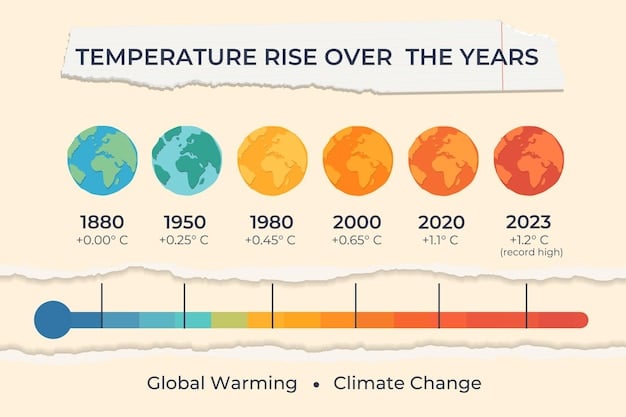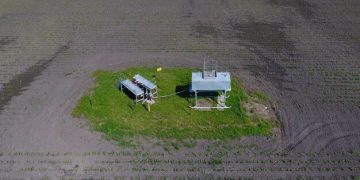IPCC Report: Urgent Climate Action Needed in the US Now!

The latest IPCC report underscores the urgent need for accelerated climate action in the US, highlighting the intensifying impacts of climate change across various sectors and emphasizing the narrowing window for effective intervention to mitigate long-term consequences.
The urgency of climate action in the United States has never been more pronounced. The latest report from the Intergovernmental Panel on Climate Change (IPCC) paints a stark picture, detailing the escalating impacts of climate change and emphasizing the immediate need for transformative action. Let’s delve into what the latest IPCC report says about the urgency of climate action in the US and what it means for the nation’s future.
Understanding the IPCC and Its Reports
The Intergovernmental Panel on Climate Change (IPCC) stands as the leading international body for assessing climate change. Established in 1988 by the United Nations Environment Programme (UNEP) and the World Meteorological Organization (WMO), the IPCC provides policymakers with regular assessments of the scientific basis of climate change, its impacts and future risks, and options for adaptation and mitigation.
IPCC reports are comprehensive evaluations based on thousands of scientific studies. These reports are crucial for understanding the consensus view of climate scientists worldwide. They serve as a foundation for climate policies and actions at both national and international levels.
The Significance of IPCC Assessments
IPCC assessments are not just summaries of existing research; they are in-depth analyses that synthesize the latest scientific, technical, and socio-economic information. The reports undergo rigorous review processes involving experts from various fields and governments to ensure accuracy and comprehensiveness.
- Scientific Consensus: The IPCC reports represent the consensus view of the global scientific community, providing a solid foundation for decision-making.
- Policy Guidance: The reports offer policymakers detailed insights into the impacts of climate change and viable strategies for mitigation and adaptation.
- Global Coordination: The IPCC fosters international collaboration by providing a common framework for understanding and addressing climate change.
The IPCC’s work is essential for informing and guiding global efforts to combat climate change, making its reports a cornerstone of international climate policy.
In conclusion, the IPCC’s reports are critical for informing policymakers and the public about the state of climate change science and the urgency of action.
Key Findings of the Latest IPCC Report
The latest IPCC report delivers several critical findings that underscore the intensifying impacts of climate change. These findings emphasize the urgency for immediate and substantial action, particularly in countries like the US, which are both significant contributors to greenhouse gas emissions and highly vulnerable to climate impacts.
One of the central conclusions is that global warming is unequivocally influenced by human activities. The report indicates that the planet has already warmed by approximately 1.1 degrees Celsius (2 degrees Fahrenheit) compared to pre-industrial levels, primarily due to emissions from burning fossil fuels, deforestation, and industrial processes.

Observed Climate Changes
The report highlights a range of observed changes across the globe, including:
Changes in the frequency and intensity of extreme weather events are another significant finding. The report notes increases in heatwaves, droughts, heavy precipitation, and coastal flooding in many regions worldwide.
- Rising Temperatures: Each of the last four decades has been successively warmer than any preceding decade since 1850.
- Melting Ice and Glaciers: Ice sheets and glaciers are melting at an accelerated rate, contributing to sea-level rise.
- Sea-Level Rise: Global mean sea level has risen by approximately 20 centimeters (8 inches) since 1900, with the rate of rise accelerating in recent decades.
These observed changes are projected to intensify further in the coming decades, with potentially devastating consequences for ecosystems, economies, and human well-being.
In summary, the latest IPCC report provides a comprehensive overview of the observed changes in climate and emphasizes the need for immediate action to mitigate future impacts.
Impacts on the United States
The impacts of climate change are not evenly distributed across the globe, and the United States is already experiencing significant effects in various regions. The latest IPCC report outlines these impacts with greater specificity, highlighting the unique vulnerabilities of different parts of the country.
Coastal regions are particularly at risk due to sea-level rise and increased storm surges. States like Florida, Louisiana, and North Carolina are facing the prospect of losing significant land areas to inundation, as well as increased damage from hurricanes and coastal flooding.
Regional Vulnerabilities
Different regions of the US face distinct climate-related challenges:
- Southwest: Increased drought conditions and water scarcity are threatening agriculture and urban water supplies.
- Northeast: Rising temperatures and changing precipitation patterns are affecting forests, agriculture, and winter recreation.
- Midwest: Extreme heat and heavy rainfall are impacting crop yields and infrastructure.
The economic impacts of these changes are substantial, with costs associated with disaster relief, infrastructure repairs, and losses in agriculture and tourism.
In conclusion, the IPCC report underscores the severe and varied impacts of climate change on the United States, emphasizing the need for tailored adaptation and mitigation strategies in different regions.
The Shrinking Carbon Budget
One of the most critical concepts presented in the IPCC report is the idea of a “carbon budget.” This refers to the total amount of carbon dioxide that can still be emitted into the atmosphere while limiting global warming to a specified level, such as 1.5 degrees Celsius or 2 degrees Celsius above pre-industrial levels.
The report indicates that the remaining carbon budget for these targets is rapidly shrinking. With current emission rates, the world is on track to exhaust the 1.5-degree Celsius budget within the next decade, and the 2-degree Celsius budget within the next few decades.
Implications for Emission Reductions
The shrinking carbon budget has profound implications for emission reduction strategies:
Meeting these targets requires deep and rapid reductions in greenhouse gas emissions across all sectors of the economy. The transition to clean energy sources, improvements in energy efficiency, and changes in land use practices are essential.
- Rapid Decarbonization: Emissions must decline rapidly and reach net-zero levels by mid-century to stay within the carbon budget.
- Immediate Action: Delayed action will require even more drastic and costly measures in the future.
- Global Cooperation: International cooperation is essential to ensure that all countries contribute their fair share to emission reductions.
The shrinking carbon budget underscores the urgent need for transformative action and highlights the importance of setting ambitious emission reduction targets.
In summary, the shrinking carbon budget emphasizes the urgency of implementing deep and rapid emission reductions to limit global warming to acceptable levels.

Mitigation Strategies for the US
Addressing the urgency of climate action in the US requires a comprehensive approach encompassing various mitigation strategies. The IPCC report provides valuable insights into the most effective measures that can be implemented to reduce greenhouse gas emissions and limit global warming.
One of the most critical strategies is the rapid transition to clean energy sources. This involves phasing out fossil fuels and increasing the deployment of renewable energy technologies such as solar, wind, and hydropower.
Key Mitigation Measures
The following measures are essential for mitigating climate change in the US:
In addition to these measures, changes in land use practices, such as reforestation and afforestation, can help sequester carbon dioxide from the atmosphere. Promoting sustainable agriculture practices can also reduce emissions from the agricultural sector.
- Energy Efficiency: Improving energy efficiency in buildings, transportation, and industry can significantly reduce energy demand and emissions.
- Electrification: Electrifying transportation and heating systems with clean electricity can reduce reliance on fossil fuels.
- Carbon Capture and Storage: Deploying carbon capture and storage technologies can help capture emissions from industrial facilities and power plants.
These strategies require strong policy support, technological innovation, and behavioral changes to be implemented effectively.
In conclusion, a comprehensive approach encompassing clean energy transition, energy efficiency improvements, and sustainable land use practices is essential for mitigating climate change in the US.
Adaptation Measures and Resilience
While mitigation efforts are crucial for addressing the root causes of climate change, adaptation measures are necessary to manage the unavoidable impacts and build resilience to future climate risks. The IPCC report emphasizes the importance of adaptation strategies tailored to the specific vulnerabilities of different regions and sectors.
Adaptation measures can range from infrastructure improvements to changes in agricultural practices and ecosystem restoration. For example, coastal communities can invest in seawalls and restored wetlands to protect against sea-level rise and storm surges.
Building Resilience
Key adaptation measures for the US include:
In addition to these measures, improving early warning systems for extreme weather events and enhancing emergency response capabilities can help reduce the impacts of climate-related disasters.
- Water Management: Implementing efficient water management practices can help communities cope with increased drought conditions and water scarcity.
- Ecosystem Restoration: Restoring degraded ecosystems can enhance their ability to provide essential services, such as flood control and carbon sequestration.
- Infrastructure Upgrades: Upgrading infrastructure to withstand extreme weather events can reduce the risk of damage and disruption.
These adaptation measures require collaboration among governments, businesses, and communities to be implemented effectively and sustainably.
In summary, adaptation measures are essential for managing the unavoidable impacts of climate change and building resilience to future climate risks in the US.
Policy Implications and the Road Ahead
The findings of the latest IPCC report have significant policy implications for the United States. The report underscores the need for ambitious climate policies at the federal, state, and local levels to accelerate emission reductions and enhance resilience.
At the federal level, policies such as carbon pricing, clean energy standards, and investments in renewable energy technologies can drive the transition to a low-carbon economy. State and local governments also play a crucial role in implementing climate policies tailored to their specific circumstances.
Policy Recommendations
To address the urgency of climate action, the US should consider the following policy recommendations:
Additionally, international cooperation is essential to ensure that all countries contribute their fair share to global emission reductions and adaptation efforts.
- Strengthening Climate Commitments: The US should strengthen its Nationally Determined Contribution (NDC) under the Paris Agreement to reflect the latest scientific findings.
- Investing in Green Infrastructure: Investing in green infrastructure projects can create jobs, stimulate economic growth, and enhance resilience to climate change.
- Promoting Climate Education: Promoting climate education and awareness can empower individuals and communities to take action on climate change.
These policy measures require political will and public support to be implemented effectively and sustainably.
In conclusion, ambitious climate policies at all levels of government, coupled with international cooperation, are essential for addressing the urgency of climate action in the US and building a sustainable future.
| Key Point | Brief Description |
|---|---|
| 🔥 Urgency | Immediate, drastic emissions cuts are essential. |
| 🌊 US Impacts | Coastal flooding, droughts, and extreme weather events. are increasing |
| 💡 Solutions | Transition to renewables, improve efficiency, adapt infrastructure. |
| 🤝 Policy | Stronger climate policies and international cooperation are needed. |
Frequently Asked Questions (FAQ)
▼
The Intergovernmental Panel on Climate Change (IPCC) is the leading international body for assessing climate change, established by the United Nations Environment Programme and the World Meteorological Organization in 1988.
▼
The IPCC report provides critical insights into the specific climate change impacts facing various regions of the US, helping guide effective mitigation and adaptation strategies tailored to local needs.
▼
The main threats include rising sea levels, intensified storm surges, and increased coastal flooding, posing significant risks to infrastructure, economies, and communities in coastal areas.
▼
Individuals can reduce their carbon footprint by conserving energy, adopting sustainable transportation, supporting climate-friendly policies, and advocating for systemic change within their communities.
▼
It’s the total CO2 that can be emitted while limiting warming to specific levels. The report indicates our budget is shrinking rapidly, meaning steep emission cuts are needed to avoid extreme warming.
Conclusion
In summary, the latest IPCC report serves as a critical reminder of the urgency of climate action in the United States. The report underscores the intensifying impacts of climate change and emphasizes the need for immediate and transformative action to mitigate future risks and build a sustainable future for all.





